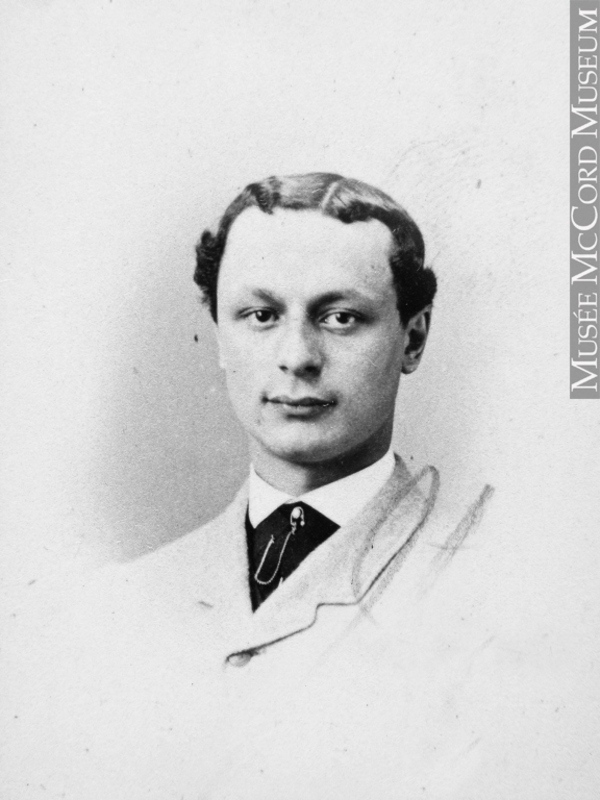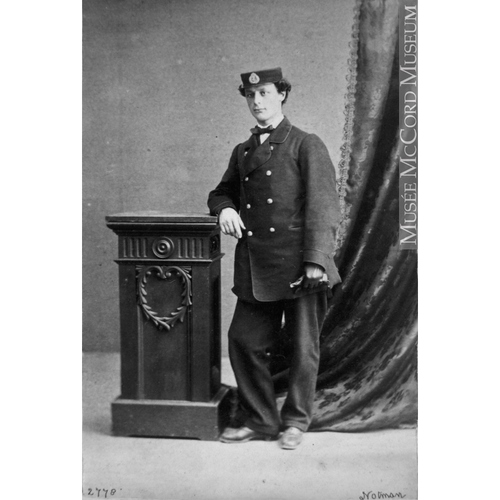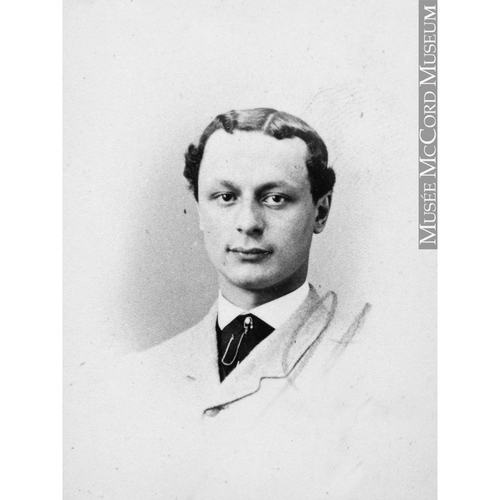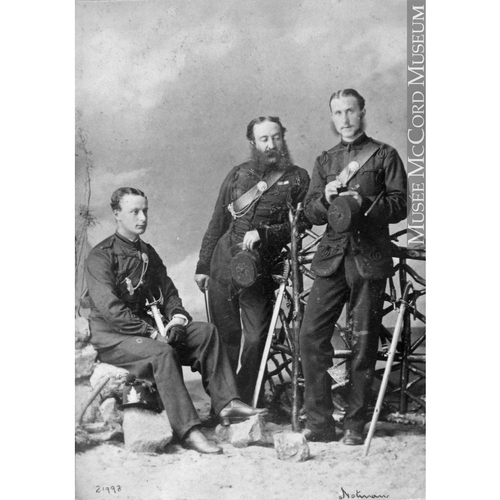
Source: Link
ODET D’ORSONNENS, LOUIS-GUSTAVE D’ (baptized Louis-Gustave-Edmond), lawyer, militia officer, and school administrator; b. 17 April 1842 in L’Assomption, Lower Canada, son of Thomas-Edmond d’Odet* d’Orsonnens, a physician, and Marie-Louise-Adeline Dorval; m. 18 April 1870 Marie-Louise-Adèle Desbarats, daughter of George-Paschal Desbarats*, in Montreal, and they had five children; d. 7 May 1905 in Lac-Mégantic, Que.
Louis-Gustave d’Odet d’Orsonnens belonged to a family of Swiss origin descended from Pierre-Louis d’Odet, the seigneur of Orsonnens in the canton of Fribourg. Protais d’Odet d’Orsonnens, Louis-Gustave’s grandfather, came to Canada in 1813 with De Meuron’s Regiment, which saw action during the War of 1812 against the Americans. He chose to remain in the country after his regiment was disbanded. Louis-Gustave would follow in his grandfather’s footsteps. After completing his education in Montreal, where his family had moved in 1845, he studied law and was called to the bar on 3 Sept. 1863, but he never seriously practised his profession as a lawyer.
In the mid 19th century Canada’s militia received an important new lease on life. Since Great Britain was at war with Russia in 1854, there were few British soldiers left here. The Canadian government passed several pieces of legislation in order to remedy this situation. The first, in 1855, authorized the maintenance of an active militia of a respectable size: seven field batteries, five artillery companies, and fifty rifle companies. The next, passed in 1856, created more such units, and the third, in 1859, authorized their organization into battalions. This was the context in which Louis-Gustave d’Odet d’Orsonnens, then only 17, had first served as a sergeant and on 17 Nov. 1859 had been made an ensign in the 1st Battalion Volunteer Militia Rifles of Canada, just formed in Montreal. In 1860 the unit was redesignated the 1st (Prince of Wales’s) Regiment of Volunteer Rifles. During the year, however, d’Odet d’Orsonnens transferred to the cavalry and was appointed standard-bearer with the 2nd Volunteer Militia Cavalry Troop. Promoted lieutenant on 3 June 1861, he temporarily left the militia the following year to join the navy and, probably, as accounts state, to pursue his studies.
In 1864 and 1865, during the American Civil War, Anglo-American relations deteriorated to the point that Canada had to reinforce border defences. Hence there was renewed interest in the militia. In June 1865 d’Odet d’Orsonnens, by then a lawyer, enlisted again, this time as a lieutenant in the 4th Battalion Volunteer Militia Rifles (Chasseurs Canadiens). He spent several months at Niagara (Niagara-on-the-Lake), Upper Canada, a border point especially at risk. The following year, with the Fenians in turn threatening to invade the country, d’Odet d’Orsonnens served in Lower Canada at Saint-Jean (Saint-Jean-sur-Richelieu), Lacolle, and Hemmingford. Promoted captain (1867), major (1868), and lieutenant-colonel (1869), he assumed various responsibilities, including those of brigade-major.
In 1883 the government, in an effort to raise the level of instruction of its militia units, approved the creation of additional permanent schools [see Richard George Amherst Luard*]. These included three for infantry, one of which, intended to meet the specific needs of the French-speaking population, was established in Saint-Jean. Lieutenant-Colonel d’Odet d’Orsonnens, who had volunteered for the assignment, was appointed by the government to set it up. Along with the officers who would command the other establishments, one in Fredericton [see George Joseph Maunsell] and the other in Toronto [see Sir William Dillon Otter*], he was sent to England in the summer of 1883 to complete his training with the British forces. The infantry school at Saint-Jean received its first students in April 1884. Second Lieutenant Oscar-Charles-Casgrain Pelletier, who would distinguish himself during the North-West campaign and the South African War, was one of the first officers to attend it. He had pleasant memories of his time at Saint-Jean, and in his memoirs, published in 1940, he noted, “The commandant was Colonel Gustave d’Odet d’Orsonnens, . . . full of initiative, a good disciplinarian . . . ; I have reason to think that choosing him as commandant was very judicious.”
While remaining head of the school, d’Odet d’Orsonnens was appointed assistant adjutant-general, and on 15 June 1889 he took over command of Military District No.6 (Montreal). He seems to have discharged this heavy responsibility to most people’s satisfaction. There is some documentary evidence, however, that in 1892 his relations with his immediate superior, adjutant-general Colonel Walker Powell*, were less than cordial. He presented a required report that prompted Powell to ask several questions. Neglecting to reply, d’Odet d’Orsonnens found himself briefly in a rather delicate situation for a senior officer. However, on 20 December of that year he wrote a letter that apparently settled the incident, which might well have cast a shadow over his noteworthy military career.
D’Odet d’Orsonnens made a name for himself abroad as well. He had visited Switzerland in 1869, probably at the invitation of the president of the Swiss confederation, and taken part in army manoeuvres. On 16 June 1874 the title of count was conferred on him by Pope Pius IX. In announcing this news, Bulletin de l’Union Allet, the official organ of the Papal Zouaves, said, “In 1867 he was one of the first to rouse Canadians to the idea of going to the assistance of the papacy.” Later it was even stated that d’Odet d’Orsonnens had been the first to propose, in 1867, the formation of the Zouaves. His title of count was hereditary “to all his descendants, solely of the male line,” under certain conditions. His son and heir, Georges-Joseph-Gustave, died in 1908. The title then passed to another son, Yvan, a Jesuit who relinquished it to his brother Henri. Henri died in 1928 without heirs.
Hunting and fishing also interested d’Odet d’Orsonnens. He was vice-president of the Quebec Rifle Association and after he left the militia on 15 July 1897 he retired to Lac-Mégantic, where hunting became one of his favourite pastimes. He seems to have been drawn for a while to writing as well, for in 1874 in Montreal he published a pamphlet entitled Considérations sur l’organisation militaire de la Confédération canadienne.
Lieutenant-Colonel Louis-Gustave d’Odet d’Orsonnens died at the age of 63 in Lac-Mégantic on 7 May 1905. The brief obituary published in the Quebec newspaper L’Événement the next day noted that he had succumbed to pneumonia following a brief illness, that a religious service would be held in Mégantic and a military one in Montreal, and that he would be interred in the family vault in Notre-Dame-des-Neiges cemetery. The interment took place on 10 May 1905.
[Lieutenant-Colonel Louis-Gustave d’Odet d’Orsonnens is elegant and distinguished, handsome with the moustache then in vogue among British officers, in the magnificent portrait which Benjamin Sulte* published in his Histoire de la milice canadienne française, 1760–7897 (Montréal, 1897); he looks the proud, dignified, and noble gentleman portrayed in historical works. j.c.]
ANQ-M, CE1-51, 18 avril 1870, 10 mai 1905; CE5-14, 18 avril 1842. NA, RG 9, I, C4, 8, 183; C6, 19–20; II, A1, 20: 3179; 82: 3081; 132: 9548; 135: 9825; 226: A9094; 281: 13925; 301: 15972; A5, 3: 219; B1, 196: 79365; 491: 42039; 492: 44216; 579: 290, 346; B3, 1–2; RG 38, 27: 7846. Bulletin de l’Union Allet (Montréal), août 1874. L’Événement, 8 mai 1905. La Minerve, 4 sept. 1874. F.-J. Audet, “Odet d’Orsonnens,” BRH, 36 (1930): 394–95. E. H. Bovay, Le Canada et les Suisses, 1604–1974 (Fribourg, Suisse, 1976), 29–35. Canadian men and women of the time (Morgan; 1898), 278. R. C. Fetherstonhaugh and G. R. Stevens, The Royal Canadian Regiment . . . (2v., Montreal and London, Ont., 1936–67; vol.1 repr. Fredericton, 1981). J.-Y. Gravel et al., Le Québec et la guerre, 1867–1960 (Montréal, 1974), 34. O.-C. Pelletier, Mémoires, souvenirs de famille et récits (Québec, 1940), 186–87. P.-G. Roy, Les avocats de la région de Québec.
Cite This Article
Jacques Castonguay, “ODET D’ORSONNENS, LOUIS-GUSTAVE D’ (baptized Louis-Gustave-Edmond),” in Dictionary of Canadian Biography, vol. 13, University of Toronto/Université Laval, 2003–, accessed January 18, 2026, https://www.biographi.ca/en/bio/odet_d_orsonnens_louis_gustave_d_13E.html.
The citation above shows the format for footnotes and endnotes according to the Chicago manual of style (16th edition). Information to be used in other citation formats:
| Permalink: | https://www.biographi.ca/en/bio/odet_d_orsonnens_louis_gustave_d_13E.html |
| Author of Article: | Jacques Castonguay |
| Title of Article: | ODET D’ORSONNENS, LOUIS-GUSTAVE D’ (baptized Louis-Gustave-Edmond) |
| Publication Name: | Dictionary of Canadian Biography, vol. 13 |
| Publisher: | University of Toronto/Université Laval |
| Year of publication: | 1994 |
| Year of revision: | 1994 |
| Access Date: | January 18, 2026 |





